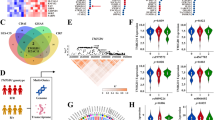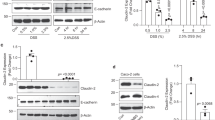Abstract
Background and Objectives
Genome-wide association studies have revealed a link between autophagy-related (ATG) genes and susceptibility to Crohn’s disease. This suggests underlying involvement of autophagy impairment in the pathogenesis of Crohn’s disease. This study was performed to investigate the pathophysiological importance of autophagy impairment in intestinal epithelial cells exposed to TNF-α.
Methods
Human colonic epithelial cells (HT-29) and rat small intestinal epithelial cells (IEC-18) were used. Formation of phosphatidylethanolamine-conjugated microtubule-associated protein light chain 3 (LC3-II) was monitored as a marker of autophagy. Autophagy was inhibited using 3-methyladenine or short interfering RNA targeting ATG5 and ATG16L1.
Results
TNF-α treatment elicited a significant dose-dependent increase in LC3-II protein levels, thus autophagy is induced in the presence of TNF-α. Combined autophagy inhibition and TNF-α treatment induced a marked increase in the number of detached cells and a decrease in activated integrin β1 protein levels. Trypan blue staining indicated 70–80 % of the detached cells were alive, suggesting that these cells became detached not because they were killed but because of dysfunction of cellular adhesion.
Conclusions
This is the first study indicating that intestinal epithelial cells with impaired autophagy lose their adhesive capacity in the presence of TNF-α. These observations indicate that impairment of autophagy leads to disruption of the intestinal epithelial cell layers in TNF-α-rich environments.





Similar content being viewed by others
References
Rabinowitz JD, White E. Autophagy and metabolism. Science. 2010;330:1344–1348.
Mizushima N. Autophagy: process and function. Genes Dev. 2007;21:2861–2873.
He C, Klionsky DJ. Regulation mechanisms and signaling pathways of autophagy. Annu Rev Genet. 2009;43:67–93.
Levine B, Mizushima N, Virgin HW. Autophagy in immunity and inflammation. Nature. 2011;469:323–335.
Hara T, Nakamura K, Matsui M, et al. Suppression of basal autophagy in neural cells causes neurodegenerative disease in mice. Nature. 2006;441:885–889.
Komatsu M, Waguri S, Chiba T, et al. Loss of autophagy in the central nervous system causes neurodegeneration in mice. Nature. 2006;441:880–884.
Sarkar S, Perlstein EO, Imarisio S, et al. Small molecules enhance autophagy and reduce toxicity in Huntington’s disease models. Nat Chem Biol. 2007;3:331–338.
Py BF, Lipinski MM, Yuan J. Autophagy limits Listeria monocytogenes intracellular growth in the early phase of primary infection. Autophagy. 2007;3:117–125.
Birmingham CL, Smith AC, Bakowski MA, et al. Autophagy controls Salmonella infection in response to damage to the Salmonella-containing vacuole. J Biol Chem. 2006;281:11374–11383.
Rioux JD, Xavier RJ, Taylor KD, et al. Genome-wide association study identifies new susceptibility loci for Crohn disease and implicates autophagy in disease pathogenesis. Nat Genet. 2007;39:596–604.
Consortium. TWTCC. Genome-wide association study of 14,000 cases of seven common diseases and 3,000 shared controls. Nature. 2007;447:661–678.
Mathew CG. New links to the pathogenesis of Crohn disease provided by genome-wide association scans. Nat Rev Genet. 2008;9:9–14.
Xavier RJ, Huett A, Rioux JD. Autophagy as an important process in gut homeostasis and Crohn’s disease pathogenesis. Gut. 2008;57:717–720.
Travassos LH, Carneiro LA, Ramjeet M, et al. Nod1 and Nod2 direct autophagy by recruiting ATG16L1 to the plasma membrane at the site of bacterial entry. Nat Immunol. 2010;11:55–62.
Cooney R, Baker J, Brain O, et al. NOD2 stimulation induces autophagy in dendritic cells influencing bacterial handling and antigen presentation. Nat Med. 2010;16:90–97.
Kuballa P, Huett A, Rioux JD, et al. Impaired autophagy of an intracellular pathogen induced by a Crohn’s disease associated ATG16L1 variant. PLoS ONE. 2008;3:e3391.
Seglen PO, Gordon PB. 3-Methyladenine: specific inhibitor of autophagic/lysosomal protein degradation in isolated rat hepatocytes. Proc Natl Acad Sci USA. 1982;79:1889–1892.
Hendil KB, Lauridsen AM, Seglen PO. Both endocytic and endogenous protein degradation in fibroblasts is stimulated by serum/amino acid deprivation and inhibited by 3-methyladenine. Biochem J. 1990;272:577–581.
Plopper G, Ingber DE. Rapid induction and isolation of focal adhesion complexes. Biochem Biophys Res Commun. 1993;193:571–578.
Koukouritaki SB, Vardaki EA, Papakonstanti EA, et al. TNF-alpha induces actin cytoskeleton reorganization in glomerular epithelial cells involving tyrosine phosphorylation of paxillin and focal adhesion kinase. Mol Med. 1999;5:382–392.
Campos SB, Ashworth SL, Wean S, et al. Cytokine-induced F-actin reorganization in endothelial cells involves RhoA activation. Am J Physiol Renal Physiol. 2009;296:F487–F495.
Kadandale P, Stender JD, Glass CK, et al. Conserved role for autophagy in Rho1-mediated cortical remodeling and blood cell recruitment. Proc Natl Acad Sci USA. 2010;107:10502–10507.
Gaur U, Aggarwal BB. Regulation of proliferation, survival and apoptosis by members of the TNF superfamily. Biochem Pharmacol. 2003;66:1403–1408.
Kollias G, Douni E, Kassiotis G, et al. The function of tumour necrosis factor and receptors in models of multi-organ inflammation, rheumatoid arthritis, multiple sclerosis and inflammatory bowel disease. Ann Rheum Dis. 1999;58:I32–I39.
Chen G, Goeddel DV. TNF-R1 signaling: a beautiful pathway. Science. 2002;296:1634–1635.
Wajant H, Scheurich P. TNFR1-induced activation of the classical NF-kappaB pathway. FEBS J. 2011;278:862–876.
Wajant H, Pfizenmaier K, Scheurich P. Tumor necrosis factor signaling. Cell Death Differ. 2003;10:45–65.
Fujishima Y, Nishiumi S, Masuda A, et al. Autophagy in the intestinal epithelium reduces endotoxin-induced inflammatory responses by inhibiting NF-kappaB activation. Arch Biochem Biophys. 2011;506:223–235.
Giancotti FG, Ruoslahti E. Integrin signaling. Science. 1999;285:1028–1032.
Campbell ID, Humphries MJ. Integrin structure, activation, and interactions. Cold Spring Harb Perspect Biol. 2011;3:1–14.
Hynes RO. Integrins: bidirectional, allosteric signaling machines. Cell. 2002;110:673–687.
Barczyk M, Carracedo S, Gullberg D. Integrins. Cell Tissue Res. 2010;339:269–280.
Gille J, Swerlick RA. Integrins: role in cell adhesion and communication. Ann N Y Acad Sci. 1996;797:93–106.
Hodivala-Dilke KM, DiPersio CM, Kreidberg JA, et al. Novel roles for alpha3beta1 integrin as a regulator of cytoskeletal assembly and as a trans-dominant inhibitor of integrin receptor function in mouse keratinocytes. J Cell Biol. 1998;142:1357–1369.
Choma DP, Pumiglia K, DiPersio CM. Integrin alpha3beta1 directs the stabilization of a polarized lamellipodium in epithelial cells through activation of Rac1. J Cell Sci. 2004;117:3947–3959.
Stutzmann J, Bellissent-Waydelich A, Fontao L, et al. Adhesion complexes implicated in intestinal epithelial cell-matrix interactions. Microsc Res Tech. 2000;51:179–190.
Kim M, Ogawa M, Fujita Y, et al. Bacteria hijack integrin-linked kinase to stabilize focal adhesions and block cell detachment. Nature. 2009;459:578–582.
Muenzner P, Bachmann V, Zimmermann W, et al. Human-restricted bacterial pathogens block shedding of epithelial cells by stimulating integrin activation. Science. 2010;329:1197–1201.
Kapron-Bras C, Fitz-Gibbon L, Jeevaratnam P, et al. Stimulation of tyrosine phosphorylation and accumulation of GTP-bound p21ras upon antibody-mediated alpha 2 beta 1 integrin activation in T-lymphoblastic cells. J Biol Chem. 1993;268:20701–20704.
Shaw LM, Messier JM, Mercurio AM. The activation dependent adhesion of macrophages to laminin involves cytoskeletal anchoring and phosphorylation of the alpha 6 beta 1 integrin. J Cell Biol. 1990;110:2167–2174.
Chou DH, Lee W, McCulloch CA. TNF-alpha inactivation of collagen receptors: implications for fibroblast function and fibrosis. J Immunol. 1996;156:4354–4362.
Van Assche G, Vermeire S, Rutgeerts P. The potential for disease modification in Crohn’s disease. Nat Rev Gastroenterol Hepatol. 2010;7:79–85.
van Assche G, Vermeire S, Rutgeerts P. Mucosal healing and anti TNFs in IBD. Curr Drug Targets. 2010;11:227–233.
Colombel JF, Sandborn WJ, Reinisch W, et al. Infliximab, azathioprine, or combination therapy for Crohn’s disease. N Engl J Med. 2010;362:1383–1395.
Conflict of interest
None.
Author information
Authors and Affiliations
Corresponding author
Rights and permissions
About this article
Cite this article
Saito, M., Katsuno, T., Nakagawa, T. et al. Intestinal Epithelial Cells with Impaired Autophagy Lose Their Adhesive Capacity in the Presence of TNF-α. Dig Dis Sci 57, 2022–2030 (2012). https://doi.org/10.1007/s10620-012-2133-4
Received:
Accepted:
Published:
Issue Date:
DOI: https://doi.org/10.1007/s10620-012-2133-4




